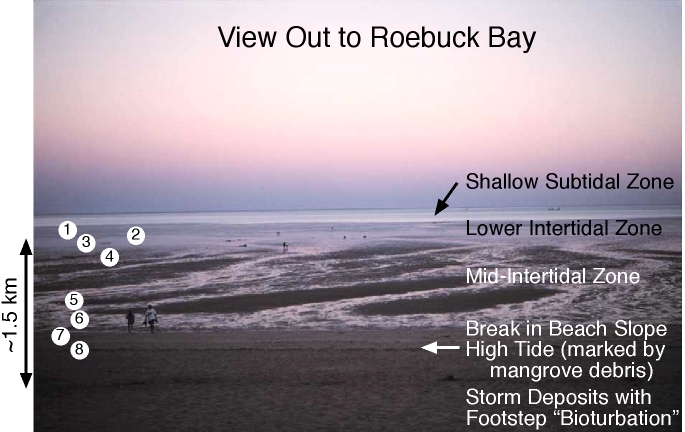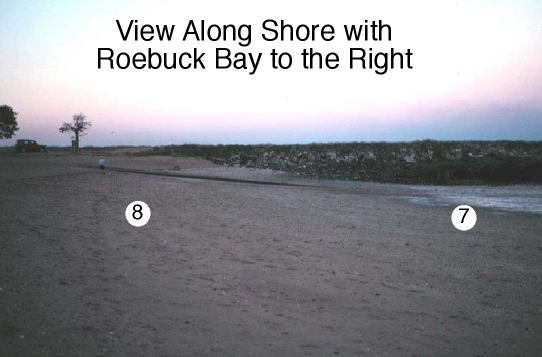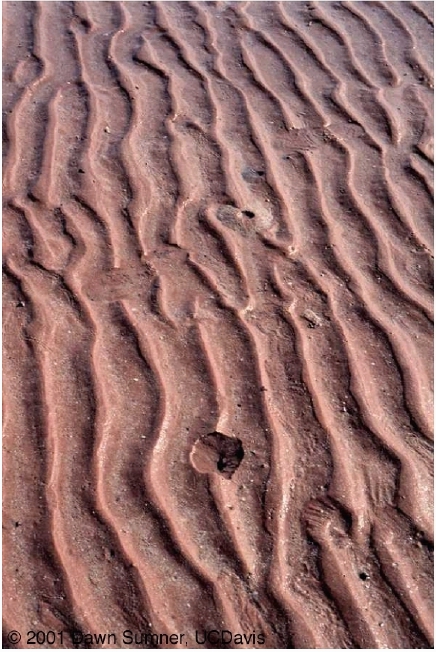7.1: Broome Town Beach Sample Descriptions
- Page ID
- 4033
\( \newcommand{\vecs}[1]{\overset { \scriptstyle \rightharpoonup} {\mathbf{#1}} } \)
\( \newcommand{\vecd}[1]{\overset{-\!-\!\rightharpoonup}{\vphantom{a}\smash {#1}}} \)
\( \newcommand{\id}{\mathrm{id}}\) \( \newcommand{\Span}{\mathrm{span}}\)
( \newcommand{\kernel}{\mathrm{null}\,}\) \( \newcommand{\range}{\mathrm{range}\,}\)
\( \newcommand{\RealPart}{\mathrm{Re}}\) \( \newcommand{\ImaginaryPart}{\mathrm{Im}}\)
\( \newcommand{\Argument}{\mathrm{Arg}}\) \( \newcommand{\norm}[1]{\| #1 \|}\)
\( \newcommand{\inner}[2]{\langle #1, #2 \rangle}\)
\( \newcommand{\Span}{\mathrm{span}}\)
\( \newcommand{\id}{\mathrm{id}}\)
\( \newcommand{\Span}{\mathrm{span}}\)
\( \newcommand{\kernel}{\mathrm{null}\,}\)
\( \newcommand{\range}{\mathrm{range}\,}\)
\( \newcommand{\RealPart}{\mathrm{Re}}\)
\( \newcommand{\ImaginaryPart}{\mathrm{Im}}\)
\( \newcommand{\Argument}{\mathrm{Arg}}\)
\( \newcommand{\norm}[1]{\| #1 \|}\)
\( \newcommand{\inner}[2]{\langle #1, #2 \rangle}\)
\( \newcommand{\Span}{\mathrm{span}}\) \( \newcommand{\AA}{\unicode[.8,0]{x212B}}\)
\( \newcommand{\vectorA}[1]{\vec{#1}} % arrow\)
\( \newcommand{\vectorAt}[1]{\vec{\text{#1}}} % arrow\)
\( \newcommand{\vectorB}[1]{\overset { \scriptstyle \rightharpoonup} {\mathbf{#1}} } \)
\( \newcommand{\vectorC}[1]{\textbf{#1}} \)
\( \newcommand{\vectorD}[1]{\overrightarrow{#1}} \)
\( \newcommand{\vectorDt}[1]{\overrightarrow{\text{#1}}} \)
\( \newcommand{\vectE}[1]{\overset{-\!-\!\rightharpoonup}{\vphantom{a}\smash{\mathbf {#1}}}} \)
\( \newcommand{\vecs}[1]{\overset { \scriptstyle \rightharpoonup} {\mathbf{#1}} } \)
\( \newcommand{\vecd}[1]{\overset{-\!-\!\rightharpoonup}{\vphantom{a}\smash {#1}}} \)
\(\newcommand{\avec}{\mathbf a}\) \(\newcommand{\bvec}{\mathbf b}\) \(\newcommand{\cvec}{\mathbf c}\) \(\newcommand{\dvec}{\mathbf d}\) \(\newcommand{\dtil}{\widetilde{\mathbf d}}\) \(\newcommand{\evec}{\mathbf e}\) \(\newcommand{\fvec}{\mathbf f}\) \(\newcommand{\nvec}{\mathbf n}\) \(\newcommand{\pvec}{\mathbf p}\) \(\newcommand{\qvec}{\mathbf q}\) \(\newcommand{\svec}{\mathbf s}\) \(\newcommand{\tvec}{\mathbf t}\) \(\newcommand{\uvec}{\mathbf u}\) \(\newcommand{\vvec}{\mathbf v}\) \(\newcommand{\wvec}{\mathbf w}\) \(\newcommand{\xvec}{\mathbf x}\) \(\newcommand{\yvec}{\mathbf y}\) \(\newcommand{\zvec}{\mathbf z}\) \(\newcommand{\rvec}{\mathbf r}\) \(\newcommand{\mvec}{\mathbf m}\) \(\newcommand{\zerovec}{\mathbf 0}\) \(\newcommand{\onevec}{\mathbf 1}\) \(\newcommand{\real}{\mathbb R}\) \(\newcommand{\twovec}[2]{\left[\begin{array}{r}#1 \\ #2 \end{array}\right]}\) \(\newcommand{\ctwovec}[2]{\left[\begin{array}{c}#1 \\ #2 \end{array}\right]}\) \(\newcommand{\threevec}[3]{\left[\begin{array}{r}#1 \\ #2 \\ #3 \end{array}\right]}\) \(\newcommand{\cthreevec}[3]{\left[\begin{array}{c}#1 \\ #2 \\ #3 \end{array}\right]}\) \(\newcommand{\fourvec}[4]{\left[\begin{array}{r}#1 \\ #2 \\ #3 \\ #4 \end{array}\right]}\) \(\newcommand{\cfourvec}[4]{\left[\begin{array}{c}#1 \\ #2 \\ #3 \\ #4 \end{array}\right]}\) \(\newcommand{\fivevec}[5]{\left[\begin{array}{r}#1 \\ #2 \\ #3 \\ #4 \\ #5 \\ \end{array}\right]}\) \(\newcommand{\cfivevec}[5]{\left[\begin{array}{c}#1 \\ #2 \\ #3 \\ #4 \\ #5 \\ \end{array}\right]}\) \(\newcommand{\mattwo}[4]{\left[\begin{array}{rr}#1 \amp #2 \\ #3 \amp #4 \\ \end{array}\right]}\) \(\newcommand{\laspan}[1]{\text{Span}\{#1\}}\) \(\newcommand{\bcal}{\cal B}\) \(\newcommand{\ccal}{\cal C}\) \(\newcommand{\scal}{\cal S}\) \(\newcommand{\wcal}{\cal W}\) \(\newcommand{\ecal}{\cal E}\) \(\newcommand{\coords}[2]{\left\{#1\right\}_{#2}}\) \(\newcommand{\gray}[1]{\color{gray}{#1}}\) \(\newcommand{\lgray}[1]{\color{lightgray}{#1}}\) \(\newcommand{\rank}{\operatorname{rank}}\) \(\newcommand{\row}{\text{Row}}\) \(\newcommand{\col}{\text{Col}}\) \(\renewcommand{\row}{\text{Row}}\) \(\newcommand{\nul}{\text{Nul}}\) \(\newcommand{\var}{\text{Var}}\) \(\newcommand{\corr}{\text{corr}}\) \(\newcommand{\len}[1]{\left|#1\right|}\) \(\newcommand{\bbar}{\overline{\bvec}}\) \(\newcommand{\bhat}{\widehat{\bvec}}\) \(\newcommand{\bperp}{\bvec^\perp}\) \(\newcommand{\xhat}{\widehat{\xvec}}\) \(\newcommand{\vhat}{\widehat{\vvec}}\) \(\newcommand{\uhat}{\widehat{\uvec}}\) \(\newcommand{\what}{\widehat{\wvec}}\) \(\newcommand{\Sighat}{\widehat{\Sigma}}\) \(\newcommand{\lt}{<}\) \(\newcommand{\gt}{>}\) \(\newcommand{\amp}{&}\) \(\definecolor{fillinmathshade}{gray}{0.9}\)Interpretation of Broome Town Beach Samples
The town of Broome is located in Western Australia (Maps from http://ebroome.com/tourism/).
I collected a suite of samples for your lab from the Town Beach at a very low tide. They are marked by the circled numbers in the photograph, and the depositional environments are also labeled.

The tidal range on this beach is about 10 m, and it has very small waves because it is protected on one side by a spit and the other by a grove of mangroves that extends into the water. A view of the shore-ward end of the spit also shows the slope of the beach face where waves break at high tide.

Sediment dispersal on the steep part of the beach is dominated by waves swashing back and forth (plus summer storms - but these photos and samples were taken during their winter). Sedimentation in the flatter parts of the beach are dominated by tidal currents, the back-and-forth currents produced by small waves impinging on the sediment surface at high tide, and the run-off of water in irregular channels at low tide. The waves produce wave ripples from near the break in slope in the shelf to more than 1.5 km off shore across a nearly flat intertidal zone. The speed of these currents is lower in deeper water, so the ripples tend to be smaller and the grain sizes finer farther off shore where the water is deepest at high tide. The following thumbnail photos show these ripples at different distances from shore.

This is a view of the tidal flat at about sample 4. Note that the ripples are linear and flat-topped. Their linear character is due to a consistent wave direction. Their tops were flattened when the water drained off the flat as the tide fell. At high tide, they would have had peaked crests.

This photo shows both current ripples (in front) and wave ripples (in back). It was taken looking across a shallow channel with water flowing from the shore to the bay at low tide across the mid-intertidal zone.

This is a closer view of the wave ripples in the mid-intertidal zone. Their tops are only slightly rounded. Note the dark line on the right side of each ripple. It marks the edge of sand that slipped down the ripple slope and indicates that the last sand transport on the ripple was to the right. The larger chuncks sitting on the sand and the white areas are shells of organisms that live in this environment. Their shells are too big and heavy for the slight wave currents to wash them out of this environment. The "crators" in the ripples are probably crab burrows and the line running across the top of the photo is another trace fossil.

These ripples, which are transitional between wave and interference ripples, are near the lower intertidal zone. The texture of the shoe prints preserves the sole texture, which suggests a large fraction of mud is present in the sediment. The "crators" are crab burrows.
Sample Descriptions from the Field
Sample BR7-00-1
- Sed Structures: interference ripples
- Fauna: abundant worms with feathery feeding apendages (1-3 cm in diameter), chitinous tube worms, some snails, some crabs, abundant tracks on the sediment surface
Sample BR7-00-2
- Sed Structures: in slow-moving tidal channel with current ripples; sediment outside of channel is similar to sediment of sample BR7-00-1
- Fauna: worms with feathery feeding apendages (1-3 cm in diameter), chitinous tube worms, snails, crabs, some sea anenomies
Sample BR7-00-3
- Sed Structures: not recorded - flat surface?; sediment felt soft underfoot
- Fauna: u-shaped worms that lie burried in the sediment and squirt water, abundant chitinous tube worms, abundant and active snails and crabs
Sample BR7-00-4
- Sed Structures: wave ripples; sediment felt coarser underfoot (I was barefoot). This site marks the first distinct coarsening of grain size towards shore.
- Fauna: common agglutinated 1 cm-diamter tube worms, abundant crabs, u-shaped worms present and decrease in abundance shoreward
Sample BR7-00-5 (collected about 200m from high tide mark)
- Sed Structures: wave ripples
- Fauna: agglutinated tube worms
Sample BR7-00-6 (collected about 5m seaward of break in beach slope)
- Sed Structures: wave ripples
- Fauna: not recorded - none observed?
Sample BR7-00-7 (in breaker zone at high tide)
- Sed Structures: smooth surface dipping seaward
- Fauna: not recorded - non observed?
Sample BR7-00-8 (collected at the high tide mark)
- Sed Structures: bioturbation by human footsteps (plus a few dog and bird footprints)
- Fauna: none observed (besides humans, dogs, and birds)


